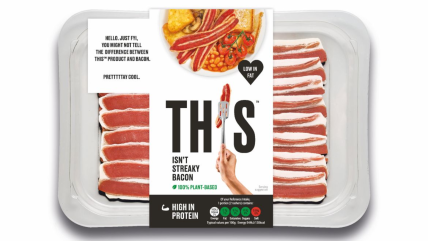
Clean label is proving a steep hill to climb for plant-based meat. The sector has faced growing criticism over its nutrition amid an increasing awareness about ultra-processed foods (UPFs) and their connection with multi-morbidity. More consumers see food products with long ingredient lists, like meat alternatives, as bad for their health.
A consumer survey conducted in 2023 and 2024 by GlobalData, Just Food’s parent, shows the percentage of consumers that see plant-based food alternatives as healthier dropped year-on-year by four percentage points in the US, and nine percentage points in the UK. Declines were also seen in countries including Germany, the UAE and Australia.
In another survey by the company carried out in the first quarter of this year, nearly a third of respondents associated plant-based meat and seafood with UPFs, while 46% were concerned about the quantity of processed foods they ate in that category.
If plant-based companies want to retain and grow their consumer base, it’s clear a focus on reformulation and educating consumers on their products is key. One company working in these areas is UK-headquartered This. Earlier this year, it set out plans to add a new whole food-centred product to its range of plant-based bacon, sausages and whole cuts.
Just Food sat down with the group’s R&D director, Luke Byrne, to discuss the stigma around plant-based meat and clean label, the rationale behind its new ‘veg-focused’ product and why producers need to work harder to educate consumers.
Fiona Holland (FH): How does the production process for This’s plant-based meats compare to how meat equivalents are made?
Luke Byrne (LB): We use a technology called high moisture extrusion, or you can use another technology which is [making] formed products. Extrusion would be more for whole cuts like a chicken or bacon or steak [alternatives] and things like that. We make our chicken and bacon basically via that and then some sausages and burgers we would make using the forming technique.
High-moisture extrusion is where most of our products come from in terms of our volume, although it’s grown in the formed side as well. On that side [high-moisture extrusion], it’s quite clean in terms of how it’s made.
The formed products are trying to mimic more like a sausage and a burger. [Take] a processed sausage, they’ll have pork in it but then they’ll also put wheat, they’ll have starch, some sulphates, preservatives and even maybe have stabilisers in there to help with shaping it and create structure. A lot of processed meats also use nitrates which [has been] linked to cancer. We don’t use things like nitrates. All we do is we take the proteins, we’ll mix them with some fat – which is plant fat, so it could be olive oil [or] coconut oil – and then we would have to use a binder which is methylcellulose, because we don’t have the animal fat [like] collagen which helps it stick together and create a firmness.
Obviously, you have to add in some fats to get the right structure and some ingredients like those stabilisers. That’s probably where we need to get better but, if you imagine, meat has been around for thousands of years, [plant-based] has been around for the last 30, 40 years… the last five to ten, this has really started to move forward. In infancy, you start to use ingredients that really help you get the structure and texture that people want. As the science moves forward, we can remove those ingredients, even though all these ingredients are food-safe.
FH: Do you still see a stigma around how plant-based meats are made? Is it a barrier This faces as it looks to grow its consumer base?
LB: Yes, 100%. Plant-based meat is nearly like its own worst enemy because consumers know the health issues associated with meat and, from an environmental and welfare perspective, why you need to move away from meat. Then with that knowledge, [they] go to consume plant-based meat and have these expectations that it must be amazingly healthy, it must be great for animals – which it obviously is – and also it must taste amazing and must pretty much mimic exactly the same texture that [they] want. It’s held to standards that are really difficult… at the minute [it’s] not impossible but it’s really difficult to hit all five, so that’s a real barrier.
Some of the barriers have been the association currently with UPF… Because of long ingredients lists and ingredients that people aren’t sure about when they look at the back-of-pack. That’s the challenge we need to [tackle]. It’s about education, it’s about trying to get people on that journey.

Of course, we’re not perfect but we need to do the right thing and the right thing is to look at the areas where we are associated, and how to remove those barriers, like trying to find solutions to ingredients that people don’t like to see on pack or aren’t sure what they are and also to make sure that the nutritional profile of what we do is correct for the consumer.
Amino acid profile is [also] really important and that’s going to become more important as we go on. We’re doing a lot of university work with the Innovate UK funding grant to work on that because plant-based has created plant-based products high in protein but now we need to make plant-based products high protein that are perfectly aligned with the right and correct amino acid profile, which is about looking at how do we combine the best plant proteins together to give that exact profile that’s needed.
FH: Are there any other challenges that This faces in tackling the clean label trend?
LB: I think the biggest thing is about consumer education. We need to find ways to communicate what we’re doing and what we’re trying to do to get them on the journey to keep the category going, to keep [it] growing for the future.
At the minute, there’s so much misinformation out there it’s unbelievable with people who are not nutritionists or do not necessarily understand what they’re talking about… I am fully optimistic about the future, it’s just really tough right now because it’s very easy for people to say one word: ‘processed’ and then it’s done.
Marketing needs to step up. They need to understand that we need to start to talk to consumers in a different way and in more simplistic terms that can help them really get on board. If we do that right, with the right product and the right nutrition, we’ll get there.
FH: Earlier this year, This said it would look to develop new products that were higher in protein, less processed and contained whole food ingredients. Why are you focused on those three targets?
LB: When you have this social media attention on UPFs and health, we need to find solutions to help that. I fully truly believe that plant-based nutrients as they are today will get cleaner. They are closer to meat, they have the texture people want, that look, that mouthful, that bite, that succulence that will stay. We will clean up that area.
We’ve created a product that is going to have the cleanest ingredients, which are basically beans, grains, pulses, seeds and leaves like kale, spinach, bringing that together with a structure that has some bite and texture that would be better than a tofu or tempeh texture but not as close as the meat replacements on the market.
FH: How easy is it to get a high level of protein in this type of product?
LB: Really, really difficult… We need to find the right whole foods that have higher protein and are lower in carbohydrate and fats and are obviously good fats to be able to get that balance. We’ll still use some flours and stuff like that to help up get there in terms of protein content but it’s about picking the right ingredients to be able to get that… and also to get the firmness we talked about as well.
FH: And will it be a more expensive product to produce? How easy will it be to source the ingredients?
LB: It’s going to be a cheaper process because this is what we’re trying to minimally process [as much] as possible but obviously grains and seeds are not as cheap as soy flour. It’s going to be more difficult but we need to be smart and you can find different ways to be able to do that.
FH: Would that make your products a bit more premium than they are now?
LB: We’re sort of premium at the minute but we would definitely have to sit on a premium level in that we’re creating a new segment in the market but it would probably sit towards [the same end as] the plant-based poultry, the tempeh, the bean burgers.
FH: The focus on minimally processed, high protein and whole foods, are those three factors something This will apply to its entire portfolio? Or is it more just a focus for this new product?
LB: I think the meat alternatives that are currently on the market that are trying to mimic meat, we need to find real good solutions to clean them up and make the consumer believe in them. Then there’s a whole new area that we can create a product that gives people who are more worried about those things something that they can have central to their diet [and] feel healthy.
When we use whole foods, the real benefit is you bring additional vitamins, minerals, antioxidants. [People] talk about meat not having vitamin B12 and iron and actually using whole foods, there’s a lot that have [both], so actually you don’t need to add that to fortify, you can have that naturally occurring.
FH: Are there any ingredients or health claims consumers are looking for in plant-based products?
LB: Higher protein is obviously essential, but they do want more… they want fibre, they want vitamin B12. They are looking for claims like minimally processed or no additives. I’m not a fan of negative claims because it’s trying to put light on something else, but actually having no additives is something that people want because it’s going to give them more belief to try that product.
FH: When it comes to the potential uptake of this product in the on- versus off-premise, is clean label something you think that retailers are looking to prioritise more?
LB: They both want it but it’s different in both ways. What we’re seeing more in foodservice is that people, if they’re flexitarians, they’ll go out and they’ll have their meat for a one-off [rather than] plant-based meat alternatives. If someone does go out and get [plant-based] they will probably go straight for the veg-led option, which we’re seeing a lot in foodservice, so this whole food product we’re going to create is perfect for them. Then the retailers are still really engaged by plant-based meat alternatives but they really want us to reduce the amount of ingredients… and focus on the nutritional profile.
FH: Do you think consumer attitudes to clean label will change in the future?
LB: People will invest more in their health. I think this trend is highlighting things that we should be focusing on quicker in the short term because we’re going to have to do it anyway. It’s the right thing to do and the right thing to look at… they’re just speeding it forward.
The interview originally appeared in the June 2023 issue of Just Food’s quarterly digital magazine, which you can read in full here.



